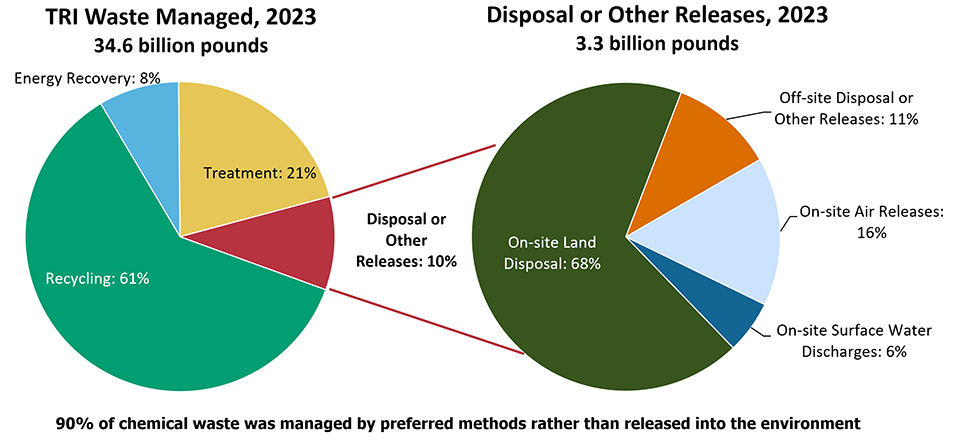Introduction to the 2023 TRI National Analysis
Under Section 313 of the Emergency Planning and Community Right-to-Know Act (EPCRA) and Section 6607 of the Pollution Prevention Act (PPA), facilities that meet TRI reporting requirements must report details about their pollution prevention and waste management activities—including releases—of TRI-listed chemicals that occurred during the calendar year by July 1 of the following year.
Watch a short video about the TRI National Analysis report.
Industries and businesses rely on chemicals to make the products we depend on, such as pharmaceuticals, computers, paints, and automobiles. While most chemicals on the Toxics Release Inventory (TRI) chemical list are carefully managed to minimize environmental releases, some releases still occur as part of routine business operations.
It is your right to know what TRI chemicals are used in your community, how chemical waste is managed—including through environmental releases—and how these quantities have changed over time.
The TRI tracks how industries manage certain toxic chemicals. Each year, facilities that meet certain criteria report data to EPA on their chemical waste management practices. This data provides valuable insights into chemical waste management and is publicly available for anyone to access.
In support of its mission to protect human health and the environment, EPA analyzes this data annually and publishes the findings in the TRI National Analysis. To learn more about how TRI data are used, explore the Catalog of Applied TRI Data Uses.
Overview of the 2023 TRI data
More than 21,000 facilities submitted data to the TRI Program for 2023. The two pie charts below summarize the data. The chart on the left shows the total amount of TRI chemical waste managed through recycling, energy recovery, treatment, and disposal or other releases. The chart on the right shows the proportions of TRI chemical waste released to air, water, and land, and transferred off site for disposal.

Note: To avoid double counting, the Disposal or Other Releases pie chart on the right excludes quantities of TRI chemicals that are transferred off site from a TRI-reporting facility and subsequently released on site by a receiving facility that also reports to TRI.
- Facilities reported managing 34.6 billion pounds of TRI-listed chemicals as waste during 2023.
- Of this total, 90% was either recycled, combusted for energy recovery, or treated, while 10% was disposed of or otherwise released into the environment.
- For TRI chemicals that were disposed of or otherwise released, facilities report the quantities of these releases and whether the releases were to the air, water, or land. Most releases of TRI chemicals occur on site at facilities. However, waste containing TRI chemicals may also be shipped off site for disposal, such as to a landfill. As shown in the pie chart on the right, most TRI chemical waste was disposed of on site to land, including to landfills, by underground injection, and through other land disposal practices.
Releases continue to decline
- Over the last 25 years, TRI releases decreased by 54% while the U.S. GDP increased by 75%.
What’s new in TRI for 2023?
- Nine per- and polyfluoroalkyl substances (PFAS) were added to the TRI chemical list. To learn more, see the PFAS Chemical Profile.
- In response to a petition, 12 additional chemicals have been added to the TRI chemical list.
- For the complete list of changes to the TRI reporting requirements, see the 2023 TRI Reporting Forms and Instructions.
Where are the Facilities that Reported to TRI for 2023 Located?
Click on any of the locations to see a facility’s TRI information.
View Larger Map
This page was published in August 2025 and uses the 2023 TRI National Analysis dataset made public in TRI Explorer in October 2024.
